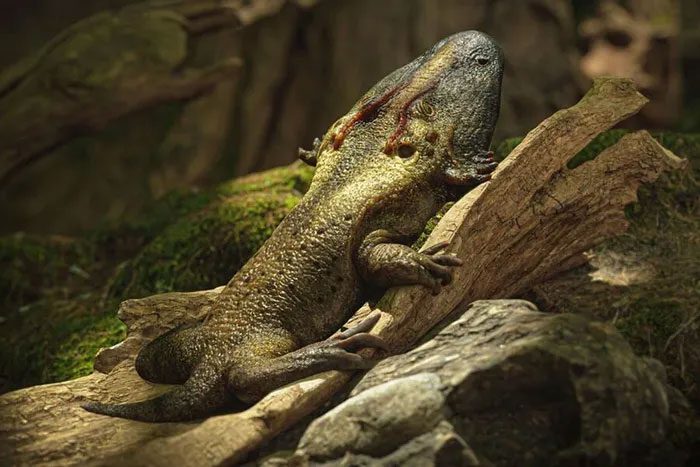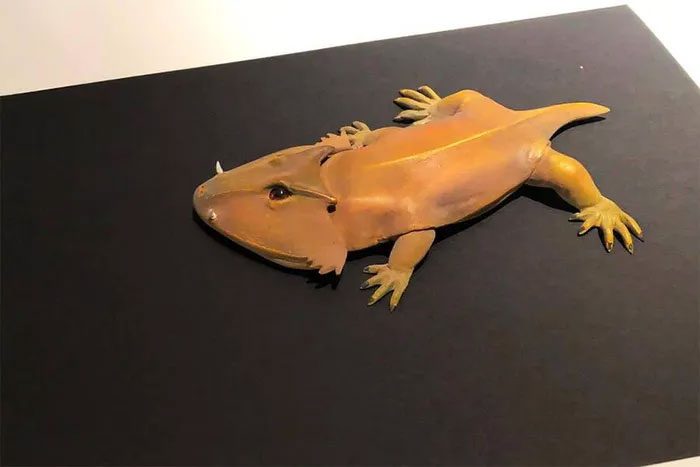Chemnitzion richteri was discovered at the site of an ancient petrified forest and is believed to have roamed the Earth 300 million years ago.
With Earth’s long history and humanity’s limited knowledge of ancient species, it is clear that there is still much we do not know about the history of animals on our planet. Recently, modern researchers have uncovered fossils that provide evidence supporting the existence of previously undiscovered organisms. Accordingly, German scientists have identified the remains of an extinct amphibian species that had been previously discovered but not classified.
According to a report from The Florida Star, this new species is called Chemnitzion richteri, discovered at “Frankenberger Road in Chemnitz-Hilbersdorf, right at the site of the local fire station today”, Ralph Burghart, a city official from Chemnitz, stated.

The Chemnitzion richteri used an ambush strategy to hunt.
According to researchers in Germany, the Chemnitzion richteri employed an ambush strategy for feeding. With its large head and small body, this creature evolved 300 million years ago in the forests surrounding eastern Germany. The new species was excavated at a site that was once a fossilized forest.
This site was once home to a petrified forest along with various ancient amphibians that lived around 300 million years ago. Researchers consider this fossilized forest to be one of the most important archaeological sites in the region.
The team conducting the historical exploration includes scientists and researchers from Chemnitz, Freiberg, Schleusingen, and Berlin.

The general structure of this species significantly differs from any known insectivorous amphibians.
Experts indicate that amphibians thrived during the late Paleozoic and early Mesozoic eras, about 400 million to 120 million years ago. According to specialists from the Chemnitz Natural History Museum and Freiberg University of Technology, the species in Germany has short legs and a large head. Scientists emphasize that its overall structure is significantly different from any known insectivorous amphibian species.
Experts from the Chemnitz Natural History Museum and Freiberg University of Technology state that this newly identified ancient organism has short legs and an extremely large head, describing it as a “bug-eating animal.”
The museum curator, Thorid Zierold, stated: “It has the ability to launch its large, sticky tongue out of its mouth to catch insects, similar to how modern frogs do. Researchers have classified it as a member of the amphibian group ‘Labyrinthodontia,’ a term from ancient Greek meaning ‘maze with teeth.’
Researchers noted that Chemnitzion richteri used an ambush strategy to hunt ancient insects and other arthropods, thriving at the end of the Paleozoic and the beginning of the Mesozoic eras.
Over time, during the Paleozoic era, significant changes in Earth’s topography occurred as continents shifted, and the planet’s climate underwent major changes, leading to the emergence of many strange organisms. According to Live Science, the evolution of life on Earth during this period coincided with a time of extremely warm weather followed by a prolonged ice age. During this time, Earth was primarily dominated by marine invertebrates, the most famous of which were trilobites.
The later Paleozoic periods witnessed the rise of terrestrial life, particularly ferns, the first trees, and a diverse array of organisms ranging from lizard-like to snake-like forms. Along with arthropods, many of the first terrestrial animals and the ancient ancestors of spiders emerged on Earth.
Arthropods began to dominate the land, and over millions of years, gradual evolutionary changes led to the emergence of a greater diversity of species, including Chemnitzion richteri.
According to the United States Geological Survey, the Mesozoic era followed the Paleozoic and produced a myriad of new life forms. This period is also known as the “Age of Conifers”, where the Mesozoic was primarily ruled by dinosaurs and included the Triassic, Jurassic, and Cretaceous periods. Alongside these giant creatures, our planet also witnessed the emergence of a vast array of flowering plants across its surface.
If researchers’ estimates are correct, Chemnitzion richteri coexisted with many famous dinosaur species portrayed in films and television.
Furthermore, while Chemnitzion richteri may resemble other amphibian species, scientists emphasize that its overall structure is distinctly different from other insectivorous amphibians.
Consequently, researchers decided to classify it as a separate species. Ronny Roessler, director of the Chemnitz Natural History Museum, informed the press that a 3D model of Chemnitzion richteri will soon be on display.
The Chemnitz Fossil Forest is one of the most important paleontological sites in the region. With 300,000 exhibited objects, the Chemnitz Natural History Museum is one of the largest and most renowned research institutions of its kind in eastern Germany.




















































